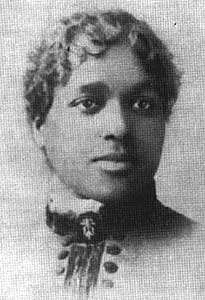Maria Louise Baldwin

Maria Louise Baldwin (September 13, 1856 – January 9, 1922) was an African-American educator and civic leader born and raised in Cambridge, Massachusetts. After teaching for a time in Maryland, she returned to Cambridge to teach at the Agassiz Grammar School. In 1889 she became principal, the first African-American female principal in Massachusetts and the Northeast. She became master of the school when it was expanded through high school grades and held that position for 40 years, establishing the Agassiz School as one of the best in the city. She was involved in black intellectual and progressive circles. During the summers, Baldwin taught teachers in other regions and also lectured publicly.
Biography
Baldwin was born to Peter L. and Mary E. Baldwin in Cambridge, Massachusetts. She received all of her education in the city's public schools. In 1874, Baldwin graduated from Cambridge High School, and a year later she graduated from the Cambridge normal training school for teachers.
Baldwin first taught in Chestertown, Maryland, for two years. In 1881, she was hired as primary-grade teacher at the Agassiz Grammar School of Cambridge. In 1889, she was promoted to principal of the school, making her the first African-American female principal in Massachusetts and the Northeast.[1] As principal, Baldwin supervised white faculty and a predominantly white student body.[1] In 1916, as a new Agassiz school was erected to include higher grades, Baldwin was made master, supervising twelve teachers and 500 students, all whites. She was one of only two women in the Cambridge school system who held the position of master and the only African American in New England to hold such a position.
Baldwin served as master of Agassiz school for forty years. Under her leadership, it became one of the best schools in the city, attended by children of Harvard professors and many of the old Cambridge families. She introduced new methods of teaching mathematics and began art classes. She was the first to introduce the practice of hiring a school nurse. Her school was the only one in the city of Cambridge to establish an “open-air” classroom. Poet E. E. Cummings was one of her students and described her thus in his book Six Nonlectures:
"Miss Baldwin, the dark lady mentioned in my first nonlecture (and a lady if ever a lady existed) was blessed with a delicious voice, charming manners, and a deep understanding of children. Never did any demidivine dictator more gracefully and easily rule a more unruly and less graceful populace. Her very presence emanated an honour and a glory: the honour of spiritual freedom—not mere freedom from—and the glory of being, not (like most extant mortals) really undead but actually alive. From her I marvellingly learned that the truest power is gentleness."
Baldwin was always learning. She took many classes at Harvard University and other colleges. She also was an instructor who taught summer courses for teachers at the Hampton Institute in Virginia and the Institute for Colored Youth in Cheyney, Pennsylvania.
Her home was the central meeting place for the Omar Khayyam Circle, an exclusive black literary and intellectual group.[2] Notable members included Clement G. Morgan, William Monroe Trotter, and others who became active in working for civil rights.[3]
She belonged to numerous civic and educational organizations, including the Twentieth Century Club, the Cantabrigia Club, the Boston Ethical Society, and the League of Women for Community Service. She lectured widely and spoke throughout the country on such Founding Fathers as George Washington, Abraham Lincoln, and Thomas Jefferson, and on such themes as women’s suffrage, poverty, and history. While Baldwin was addressing the council of the Robert Gould Shaw House Association at the Copley Plaza Hotel in Boston, on January 9, 1922, she collapsed and died suddenly of heart disease.
Legacy and honors
- Her home from 1892 on has been preserved as the Maria Baldwin House and was designated as a National Historic Landmark. It is privately owned and not open to the public.
- On February 12, 2004, Agassiz School was officially renamed as the Maria L. Baldwin School. The campaign was initiated by an eighth-grade student at the school and actively supported by other students and the principal.[4][5]
- Baldwin is noted on the Boston Women's Heritage Trail for her connection with the League of Women for Community Service.[6]
See also
References
- 1 2 "Claiming Their Citizenship: African American Women From 1624-2009". National Women's History Museum. Retrieved 2013-03-03.
- ↑ Jones, Angela (2011). African American Civil Rights: Early Activism and the Niagara Movement: Early Activism and the Niagara Movement. ABC-CLIO. p. 242. ISBN 9780313393617.
- ↑ Carle, Susan D. (2013). Defining the Struggle: National Racial Justice Organizing, 1880-1915. Oxford University Press. p. 183. ISBN 9780199945740.
- ↑ "The Mismeasure of Maria Baldwin". Peacework Magazine. April 2002. Retrieved 2013-03-03.
- ↑ Dorgan, Lauren R. (May 22, 2002). "Committee Renames Local Agassiz School". The Harvard Crimson. Retrieved 2013-03-03.
- ↑ "South End". Boston Women's Heritage Trail.
Further reading
- The African American Registry: Maria L. Baldwin, graceful educator
- Agassiz Neighborhood Council: Agassiz Neighborhood Notables
- Maria L. Baldwin School: Maria L. Baldwin Biography
- Blackseek.com/black history daily: Maria Baldwin, A Woman of Education